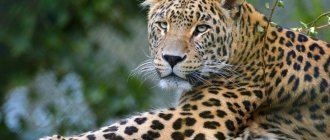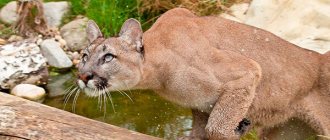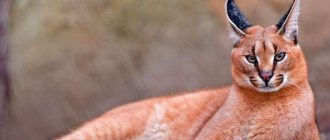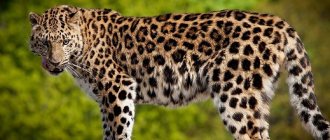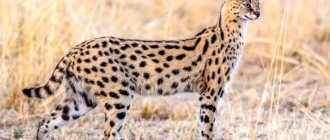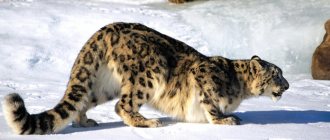External features of the animal lynx
The photo of the animal lynx shows an outwardly attractive, fluffy cat, the length of which varies from 80 to 130 centimeters. Height at withers 50-70 centimeters. Basically, the size of a lynx is similar to that of a large dog. An adult lynx weighs from 18 to 35 kilograms. The cat's ears end in long tufts and the tail is short. The lynx's large, high paws, which grow long hair in winter, help them move through the snow without any problems.
Depending on the territory where the lynx lives, its color varies, from red to smoky, with spots on the back, sides and paws. The predator has a unique silky coat. The claws of the lynx, like those of other feline predators, do not leave imprints on the snow.
Features of color
The coat of these animals depends on their habitat and is represented by many options, including different colors. Therefore, there are species with a reddish-brown color, as well as types of pale-smoky tones, as well as their variants. In this case, a pattern may appear on the body in the form of spots on the back and paws, including on the sides of the predator.
The lynx's belly is covered with long and fairly soft hair, but not thick, distinguished by a white tint, with barely noticeable specks. Lynxes living in the southern regions are characterized by a red coloration, while they have relatively short and dense hair. Lynxes shed twice a year, both in spring and autumn.
Lynx habitat
The territory where the lynx lives is the north; sometimes it lives even beyond the Arctic Circle. The lynx's favorite habitats are dense forests, although it is found in a variety of places.
Previously, the predator was distributed throughout European territory, but in the 20th century it was exterminated in many countries. At the present time, successful attempts are being made to revive the lynx. In the Russian Federation its numbers are small.
Zoroastrian horoscope
The period of activity is the cold season, the winter season gives the totem strength, and the inherent coloring of the lynx strengthens its natural strength. The color is gray, which from time immemorial has been associated with the veil that stores ancient knowledge and separates the obvious from the secret. According to the Zoroastrian horoscope, the years of the cycle are: 1929, 1961, 1993, 2025, 2057.
In mythology, the Lynx was credited with the ability to see through walls, predict places with traps, and endowed her with extraordinary courage, so that she could even argue with a bear. The sign of the Lynx follows the Swan and symbolizes foresight, a state of insight and illumination. The main goal in life is to explore the unknown.
Antitotem
The opposite sign is the Mouse. Under the power of the antitotem, they show extreme cowardice. Such people are called “suckers”, they are not respected because they do not have their own point of view and are ready to bend to anyone who is stronger than them. They are very dependent on the assessment and opinions of others, they will do everything not to lose importance in the eyes of other people, but with all their actions they come to the opposite.
They are often the instigators of fights when there is a strong opponent on their side. They add fuel to the fire and try to quickly retreat from the scene, leaving their comrade to take the rap for them. The main features of the Mouse are deceit, slipperiness, extreme forms of hypocrisy and tediousness.
Lynx animal diet
The lynx is an excellent hunter, which is aided by its excellent ability to climb trees. Another factor that helps in hunting is good camouflage. Spots on the fur make the lynx invisible during the day, among the glare of the sun, and help to hide at dusk, which makes it easier to attack the prey.
If there is enough food, then the lynx lives in one place, but if not, then it moves. It can travel within thirty kilometers per day.
Basically, what the lynx feeds on are hares, grouse birds, small rodents and small ungulates, as well as sables and foxes. Rarely attacks domestic dogs.
The lynx's favorite time of day for hunting is twilight. She prefers to ambush her prey or sneak up on her at a close distance, which can be overcome in one jump. The cat's jump reaches four meters. He likes to hide behind large stones or fallen tree trunks.
Does not pursue prey for more than a hundred meters. The lynx digs its claws into large prey and strangles it. The predator does not eat much meat at a time, hides the leftovers, but does not do it carefully and often the prey is carried away by other predators. Depending on the size of the prey, it can store uneaten leftovers for up to one and a half weeks.
It happens that during a hunt, a lynx, a more skilled hunter, is pursued by a wolverine. After the cat has caught the prey, the wolverine drives it away and eats the meat of the killed animal. Lynxes, like wolves, are considered forest orderlies, since they kill mainly sick and weak animals.
Lifestyle and habitat
Since these animals are now few in number, they lead a predominantly secretive lifestyle. Accordingly, the chance of seeing it in the wild is quite small. Even with a strong desire, it is not so easy to find a cat, since it prefers such supports that are not easy to get close to. For example, it could be an old cluttered windfall or a dark taiga forest with a dense undergrowth of coniferous trees.
However, there is a chance to meet a lynx in a young forest. The predator does not attack humans, preferring to avoid encounters. The animal is able to recognize the presence of a person at a distance of several hundred meters, after which it begins to silently leave, occasionally stopping to listen.
If the lynx is very hungry, it may even go into the city, where it will attack a dog or cat. Even an adult shepherd cannot compare in strength to a predator. However, few cases of lynx appearing in cities have been observed, as they prefer dark coniferous forests.
Lynx is a wild animal , therefore it prefers a nocturnal and twilight lifestyle. It starts hunting after dark. It feeds mainly on hares. If possible, it may attack an ungulate animal: roe deer, wapiti or young wild boar. Easily catches a squirrel or marten. The meat of hazel grouse, black grouse and wood grouse is considered a favorite delicacy. In the winter season, it tracks holes.
An interesting fact is that the lynx does not like foxes, so it hunts them as soon as the chance arises. However, he doesn’t eat it. The hunting qualities of these cats are even better than those of leopards and wolves. With the onset of evening, everything around becomes silent and at this time the lynx goes out to hunt, listening to the smallest sounds.
Having determined that there is prey nearby, the cat slowly makes its way to it, without making unnecessary noise. A convenient distance for an attack is considered to be 10–20 m. 2–3 jumps are enough to grab onto the food. If the prey, for example, a hare, senses something is wrong and starts to run away, the lynx may chase it for a short time, 50 - 100 m, after which it stops.
Sneaking is not the only hunting style. He also prefers a wait-and-see position, in ambush. Favorite places are hare trails or ungulate watering holes. The lynx does not like to jump from trees, although it can rest on branches with all 4 paws hanging down.
Prey in the form of 1 hare will be enough for a cat for 2 days. If the trophy is a roe deer, this provides the animal with food for the week ahead. It happens that the prey is too large, in which case the lynx buries it in the ground or snow, depending on the time of year.
The lifestyle is sedentary. Looking for prey, it can move over distances of up to 30 km. Lynx is a predator that prefers solitude. The only exception is females with cubs - they spend several months together. This is enough to teach newborns hunting skills.
First, the female brings live animals to the babies, for example, mice or hares. After they grow up, the lynx begins to take their offspring with them on hunts. With the onset of February, the adult will drive the kittens away, since it is time for them to survive on their own in the taiga.
All types of lynx
There are several subspecies of lynx:
- Ordinary. The most common subspecies of lynx.
- Canadian. Mainly distributed in Canada. The fur is grayish-brown. Half the size of the common lynx.
- Pyrenean. Habitat: southwest Spain. The rarest subspecies living in the wild. It is listed in the Red Book and is the rarest mammal on earth. The fur is light in color and has bright spots.
- Redhead. Habitat: United States of America. The fur is red with a gray tint, but there are individuals that are completely black - melanistic. It is seriously inferior in size to the common lynx and weighs only 6-11 kilograms.
Diet of a predatory cat
The lynx's main prey is white hares, but the predator cannot cope with them alone. She will happily snack on a bird or rodent. Favorite dishes are partridges, black grouse, squirrels and mice. In addition, the red cat's menu includes not very large ungulates, such as musk deer, roe deer, sika and reindeer. To keep a lynx from being hungry, a twenty-kilogram individual requires about 3 kg of meat per day, and if the animal is too hungry, it can easily consume as much as 6 kg.
Meat is meat, but the spotted predator also requires fresh fish, but the lynx can only feast on it in the spring, at that happy time when it spawns in shallow water. Then the cat can simply fill his paw with as many fish as his heart desires.
Lynx breeding
At the beginning of spring, the lynx begins the mating season, during which, the rest of the time, the quiet cat makes piercing sounds: screams and meows. During this period, several males fighting among themselves follow the female.
The resulting couple sniffs each other and rubs their foreheads. When cats become attached, mutual licking of fur occurs. The rest of the time, with the exception of the breeding season, the cat prefers solitude.
The female bears it within seventy days, after which 1 to 5 deaf and blind lynx cubs are born. Kittens weigh about three hundred grams. The lynx chooses earthen caves, rock crevices or among windbreaks as a den for its offspring. Lynx cubs begin to see on the twelfth day, and at one month they can already eat solid food.
Both the male and the female are involved in raising the offspring. Growing kittens live and learn to hunt with their parents until the next mating season, and then leave and live separately. By the age of two, the female is capable of reproduction, while the males are only capable of reproduction by the age of three. Lynxes live for about 15-20 years.
Behavior
Canadian lynxes are solitary, territorial animals. Although the home ranges of several females may overlap, males occupy separate territories. A male's home range includes that of one or more females and their young. The size of the occupied territories varies from 11 to 300 square kilometers. Adults tend to avoid each other except during the winter breeding season.
North American lynxes primarily rely on their eyesight, but also have well-developed hearing. Lynxes hunt mainly at night. However, activity can also be observed during the day. They usually stalk prey and then jump on it, although some individuals can ambush their prey for several hours. The lynx is able to walk 8-9 km every day to provide itself with food and moves at a speed of 0.75-1.46 km/h. They are good swimmers and skilled climbers, however, they hunt only on land.
Females and cubs sometimes hunt hares in groups. One lynx scares the prey, and the rest line up and catch it. This hunting method can be very successful and is important in developing hunting techniques among the young.
Enemies of the lynx in the wild
Despite the small commercial value of the lynx, only fur is used; the main enemy of the predator is humans. In addition to humans, in nature, the enemies of the lynx are wolves, which are characterized by pack hunting and relatives who want to occupy the developed territory or kill kittens.
A single cat tries to avoid the territories where wolves live, since entering into battle with a pack means dooming oneself to death in advance.
Regarding its relatives, the lynx marks its boundaries, and if they are violated, it can scare away uninvited guests with a hiss or engage in a fight.
Natural enemies
Photo: Lynx in Russia
In addition to the man who has been exterminating the lynx for many years, it also has natural enemies.
First of all, these are all the other big cats:
- jaguars;
- cougars;
- Canadian lynxes.
In winter, especially in hungry years, a pack of wolves poses a significant danger to a lone cat. They surround their prey and mercilessly tear them to shreds. If a lynx meets a wolf one on one, it has every chance of defeating it, but against an entire pack it is powerless.
In a battle for prey, a lynx may be defeated by a tiger or snow leopard. They can fight with her for prey that the cat has already killed, and the lynx often flees in such situations. For the same reasons, wolverines are considered its enemy. The animals, although small, are very annoying to the cat; they are able to drive away a larger predator from their own prey.
But small lynx cubs can become prey for literally any predator that is larger than them. Not only foxes, wolves and other cats try to get into the family nest, but also bears. However, the female rarely leaves her kittens; she fiercely protects them from any uninvited guests.
Lynx at home
The caracal is a domestic lynx, characterized by excessive energy and a pronounced hunting character. Initially, the predator was tamed for hunting game; the ownership of this animal began to be a sign of wealth.
The habitat of wild caracals is Africa and Asia. The caracal is smaller in size than the common lynx. The short coat is sandy in color with dark ears. The weight does not exceed 25 kilograms, and the height is 50 centimeters. The predator feeds on meat and eats up to one and a half kilograms per day.
Caracals are ready to breed when they reach one year of age. The mating season lasts from early autumn to early winter. This is mainly due to the animal having excess food at this time of year. Pregnancy lasts for 2-4 months. Usually 2 to 7 lynx cubs are born. By six months, kittens begin to live independently.
Caracals have strong natural immunity and rarely get sick. Such predatory cats live for about fifteen years.
Role in the ecosystem
In regions where hunting is not practiced, the common lynx may play a role in controlling the deer population. Every year, they kill from 10 to 40% of European roe deer, deer and chamois. This largely depends on lynx density, ungulate density, and other causes of ungulate mortality. The greatest impact from lynxes was observed on the chamois population. The Eurasian lynx also suffers from numerous internal and external parasites.
